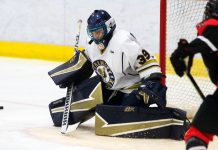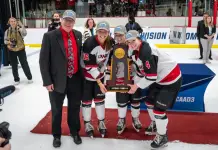I spent the last two weeks in Sweden for the 2023 IIHF U18 Women’s World Championships. I’ve always had an interest in this tournament, but having the chance to cover the 2022 tournament in Madison really drove home for me how closely tied it is to what I do covering the college game. I was already trying to find a way to make going to Sweden feasible before the 2022 tournament was even finished.
I had been among the people disappointed and loudly upset with poor streams for past iterations of the tournament, but hadn’t really committed to covering the games or the players in a meaningful way before last summer. With the tournament happening 6-9 hours ahead of most North American time zones and the broadcasts in the US only on the NHL Network, the games were broadcast in better quality, but weren’t necessarily more accessible than they had been in the past, making my feel it was even more important to be on site, telling the teams’ stories.
I learned a lot, but there were a couple of things relevant to college hockey that I wanted to make sure to share.
Holding the 2022 tournament at the University of Wisconsin in Madison renewed interest in the NCAA from non-North American players.
For some country’s players, playing in the NCAA has never been more popular. But for others, access to high level women’s leagues at home has given them more options. Add in the pandemic that kept international travel and college visits, European camps and international scouting trips from the universities at a minimum and the NCAA path wasn’t as much of a focus or priority for many players.
Seeing Wisconsin’s facilities and experiencing what it can be like to play in that environment rekindled interest in the American college path for many who played in the 2022 tournament, I was told by one team official. Many of the teenagers weren’t aware of the level of support collegiate students get beyond just coaches and ice time and the tournament encouraged them to do more research into schools across the country. It wasn’t just that they decided they wanted to end up in Madison. They understood that every school has different amenities and facilities and that there are 40 other programs at just the DI level that might be a good fight for them.
For many of the players on teams other than the US and Canada, they are still a year or more out from making a decision, so there weren’t any current commits reported to me by team reps from Sweden, Finland, Czechia, Switzerland, Slovakia and Japan.
Social media impact
Younger European players who hope to play in America already have their favorite and preferred schools and while some of that has to do with national championships won, it also has to do with which players went to that school. It seems to matter less what the programs themselves are putting on instagram and tik tok and more what kind of content, personality and access international players have that allows the younger players to connect with them. The teenagers are attracted to certain schools because the players they know went there. It matters to them that the players are personable and charismatic and that makes the teenagers want to follow in their footsteps, including attending the same school.
Experience matters
This is obvious, but in this case, I don’t mean this in the traditional sense. I feel like one of the big takeaways I have from attending this tournament twice in the last six months is how important it is to have current and former women’s hockey players on the coaching staff who have been in these players’ skates and who can speak with authority on how to handle themselves, particularly in the toughest situations.
I’m not saying those will be the only successful coaches, but I do think there’s no better way to recapture a locker room and demand attention than to be someone those players have watched growing up. The respect has already been earned. And when those coaches talk, their words hold extra weight. These are teenagers, most of whom are playing in their first major international tournament. Coaches have a limited amount of time to really create a team and get them to buy in. The cache former players have puts them a few steps ahead, I think. Not only have those coaches paved the way on the ice, but they’ve stuck around to continue to help push the sport forward.
We need another tier of competition
I’m open to it being U20 or U22 or something else entirely, but watching this tournament made me think about the players I watched six months ago that didn’t head into the NCAA and didn’t make the leap to their senior national team. I was thinking of late blooming players who don’t reach their peak until their 20’s or even after college. There’s this massive gap between U18s and senior national teams and we are losing talented players and the opportunity to add depth to program’s across the world.
There has to be a better way
Folks outside of Sweden may have heard of TV-Pucken, their national tournament for U16 teams representing 24 districts around the country. I learned that TV-Pucken is sometimes the beginning, but more often the end of career aspirations for teenagers across the country. Making your region’s TV-Pucken team (or not) can dictate what club and international opportunities a player gets, as well as which high school they get into (and there are hockey development high schools). That means a player must stand out at 15 or so years old or risk being left out of any chance to play for Sweden or in one of the domestic leagues.
In a country where the head of the Federation has talked about the need for better support and development of girls hockey across Sweden, it is crazy to expect that a girl who has little access to top tier coaching and competition should be able to stand out enough to make their region’s TV-Pucken team (particularly in crowded Stockholm) before they’re in high school and if they don’t, the question of whether they made the TV-Pucken team will follow them on every avenue they try to utilize to keep playing and improving in the future.
More stats
I don’t know why, but official IIHF stats at this tournament do not keep track of blocks and it frustrates me to no end. The way players laid out (particularly Finland and Sweden in the semifinal games) and sold out to keep their team in a game was such an important story line and I wish I had the numbers to back me up. Yes, I could try and track it myself, but I shouldn’t have to. I had a suboptimal gameday experience as working press trying to cover each game and finding time (and space) to do my own stats feels laughable at best.
I just wish folks (federations, programs, governing bodies…) didn’t make it so damn hard to cover women’s hockey.


